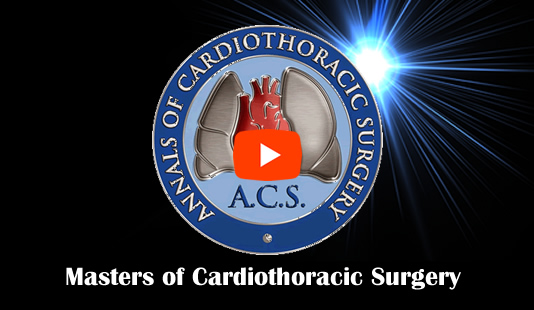The initial concept for the Mini-Maze was developed in 1987. This was done by Dr. Wolf and a small group of researchers who developed radiofrequency (RF) clamps using very simple elements that you can find in a store such as Lowe's or Home Depot! Do not worry, these early prototypes were only for non-human research and used on samples of tissue bought from stores. These devices are today made by medical industry and are manufactured and sterilized to very high standards.
Their challenge then was to develop a more benign and less invasive method to the surgical procedures being used at the time, circa 2000. The issue with those earlier surgeries, and some in use today, was that they required extracorporeal circulation, that is, the patient needed to be hooked up to a heart-lung machine, and their heart had to stop beating. This extended the time spent in the operating room table and added potential complications associated with these machines. Because of the need to cut open the breastbone (sternotomy), recovery could take at least a week or more. It was a massive, invasive cardiac surgery. It worked, but it was riskier and more difficult.
Pulmonary vein isolation with left atrial appendage exclusion
This was the descriptive name given initially to Dr. Wolf's procedure. It was first done in a human in 2003 with extremely positive results. The procedure was predicated on creating total atrial transmural (across the wall) RF ablation lines around the pulmonary veins that enter the left atrium, and concomitantly close the left atrial appendage (LAA). Initially the exclusion of the LAA was done using surgical staplers. Today this is done a specially designed clip. In both cases the LAA is excluded from circulation eliminating its role in the formation of stroke-producing clots, and also eliminating the AFib-producing electrical activity of the LAA.
The procedure reduces the time the patient spends on the operating table, does not require a heart lung machine, does not require the heart to be stopped, and does not require a sternotomy, a seven inch incision that cuts through the breastbone. This incision is the main post-operative cause of pain and is the one that requires a long rehabilitation time. The procedure is performed via trocar ports and two 5 cm small incisions between the ribs. These incisions heal extremely fast as proven by patients that return to an active lifestyle only a couple of weeks after the procedure.
Why the Mini-Maze name?
Dr Wolf explains it as follows: "The name "Bilateral Pulmonary Vein Isolation with Left Atrial Appendage Exclusion" or "PVI+LAAE" was too long and complicated for anyone to use. A couple of years after routinely doing this procedure a patient came to me and said "Dr. Wolf, thanks for helping get rid of my AFib... I have a gift for you", and he proceeded to show me a website that he had developed using a new name for the procedure and the website. He called it the Wolf Mini-Maze and some patients in our Facebook page abbreviated it as WMM... easier to use! I had nothing to do with the name or the original website". Since then, the website has changed several times, but the name for the procedure stuck.
WMM Procedural Video
Here is a 51 minute detailed video of the WMM procedure that was taped with the patient's consent. To see this age-restricted video you will have to sign in with your Google ID. The video, narrated by Dr. Wolf, is part of the series "Masters of Cardiothoracic Surgery" produced by Annals of Cardiothoracic Surgery. Be forewarned, the video shows the patient's body, the whole procedure, the inside of the operating room, and steps in the procedure. It may not be suitable for children.
The video was made to be seen by other surgeons. In the video Dr. Wolf uses proper medical terms some of which we have covered in the articles in this website. Note that extracorporeal circulation is not used,
Dr. Wolf refers in this video to the "ganglionated plexi", also known as the "ganglionated plexuses", how he isolates them with an RF clamp and tests to confirm this isolation. He is referring to a component of the heart's autonomic nervous system that forms a meshwork of nerves within the walls of the atria, a large percentage of which are found in the more superficial aspect of the heart wall. This is why it is so important to attain a complete transmural (across the wall) ablation of the atrial wall.
When this video was published there were close to one thousand patients that had undergone a WMM. Today, (August 2023) this number is close to three thousand!
 This video is age-restricted and only available on YouTube
This video is age-restricted and only available on YouTube
Video Time Topic
- 00.00.00 Video start
- 00:00:40 Preparation
- 00:04:56 Right side incisions
- 00:08:40 Pericardium entry
- 00:13:45 Signal testing
- 00:18:55 Right pulmonary vein isolation
- 00:21:58 Stamping technique
- 00:27:22 Intercostal block
- 00:32:16 Body Rotation
- 00:33:21 Left side incisions
- 00:38:48 Left pulmonary vein isolation
- 00:43:38 Left atrial appendage exclusion
- 00:47:03 Closure
Note : All of these video links will open in separate windows
If you are interested, make sure you view this video and take notes so that we can answer any and all of your questions. There are many patients that have given us their testimonials. Do not take our word for it. Read and chat with other patients and their experience Mini-Maze Facebook page so you can make a well-informed decision. You can also go to our Educational Videos page to watch and read Dr. Seth Evans' experience as a surgeon and as a patient.